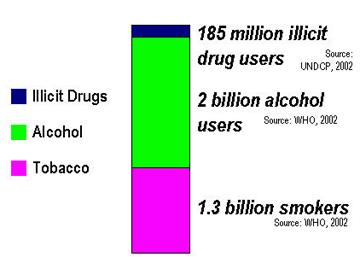Substance Abuse and Preventive Measures
The use of psychoactive substances has posed a grave threat to the health of multitudes and hence, has drastically intertwined with the socio-economic status of families, communities, and nations around the globe. An astonishing survey of substance abusers would intensify one’s concern over the cause, and the extent to which drugs and the related types have fabricated lives.
World extent of psychoactive substance use

These alarming figures force one to delve into the issue and trace the origin and development of substance abusers. Substance abuse relates to the hazardous effects of psychoactive substances as alcohol and illicit drugs on the individual leading to increased anxiety and dependence – extensive behavioral inconsistencies, psychological and physiological traumas, the inability to control its desire, and persistent use increasing chances of permanent disabilities, withdrawals and subsequently death. This might seem yet another medical problem, though it fails in this respect. This problem not only relates to medicine but also social and economic inadequacies.
It is seen that children and adolescents form vulnerable groups. People worldwide have addressed substance abuse as part of an activity of daily life. Often, casual users end up as the affected and gradually it spreads among groups of peers which eventually leads to habit formation. Women and adults are less affected but they still form a significant majority contributing to the use of alcohol and related drugs. Countries, globally, are prey to the menace.
A serious peep into the reasons that account for this abuse range from unhealthy families to faulty policies and ineffective control measures. Analyzing each aspect wouldn’t be a futile attempt in searching for stringent preventive methods.
Chaotic and insecure families wherein there is a lack of mature parental guidance, and least parental attachment has greatly contributed to wanton behavior in children and adolescents. Women and adults who fall prey to unhealthy marital relationships, financial burdens, and incapacities are targeted. The most influential is the peer group. Cultural and social attitudes of a community or nation have also aggravated this concern.
Generally, the vulnerable seems aggressive or shy and develop poor social adjustments, poor school performance often resulting in dropouts or suspension, forgetfulness, depression, selfishness, desire to sex giving up sports and past activities. These symptoms can be best noticed by friends, parents and relatives of the affected ones. If the habit goes undetected the person would gradually fall into seizures, hallucinations, cancer in the stomach, pancreas, liver failure, heart enlargement, and ultimately death. Excessive hunger, sleep disturbance, depression, and irrational behavior develop when the person is deprived of the drug and the related that he has been injecting himself with. A cursory glance through these lines would enhance any reader to realize the gravity of the situation as it affects not only a certain section of the society but a sizable proportion of all age groups of either sex.
Hence, it has become mandatory that the right measures in this direction be taken to save the world from possible destruction of manpower and intellectual waste. The WHO is an organization established in 1948 which has continually contributed to addressing this social concern. In 2000 the Department of Substance Abuse merged with the Department of Mental Health to form the Department of Mental Health and Substance Abuse. The efforts of this team have resulted in continual development, testing, and evaluation of cost-effective interventions for substance use disorders as well as the generations, compilation, and dissemination of scientific information on substance use and dependence, their health and social consequences.
Apart from these measures, it is the need of the hour to protect innocent lives from being misguided. This requires effective steps and efforts by the inter-related support of various medical institutions, social workers, welfare organizations, relatives, friends, and parents. Programs aimed to teach resistance skills, should be enhanced. The media, the medico officials, anti-narcotic squads, addiction rehabilitation centers should work round the clock to provide relief to the victims. Primarily, a secure and loving home atmosphere grounded in basic human values supported by guidance and right-thinking could be the panacea for the addicted. Every family unit needs to rise to the occasion.
As a parting note, it is obvious that security, healthy practices, faith, strong family ties need to be advocated so that numerous social evils are uprooted. It would be unsafe to point fingers at one another for the advancement of this issue and the plausible consequences. Spiritual and intellectual values need to be instilled right from childhood through adolescence. A caring atmosphere can foster healthy attitudes in an individual. Society should not shun the affected but it should rise up to lend a hand to the sufferers – individual and his family. Many times, the affected go unheard and uncared, resulting in the loss of precious lives. It should not be the duty of any particular organization alone, but the right of every individual to be a part of the group that would cater to the public interest. Give care and take care.